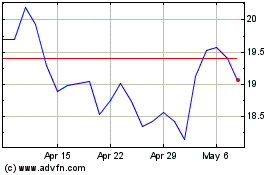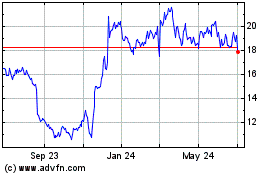By Michael Wursthorn
Investors counting on a corporate earnings rebound in the second
half of the year are risking disappointment.
Wall Street analysts have cut their third-quarter profit
estimates in recent weeks, painting a bleak picture for investors
already grappling with a simmering trade war, pockets of economic
weakness and ominous signs from the bond market.
Despite this week's partial reprieve from the Trump
administration, the latest round of tariffs on Chinese imports
compound the problems already facing many companies and threaten to
stifle their profit margins. Especially vulnerable are
manufacturers, miners and retailers.
At best, earnings across the companies in the S&P 500 will
grow 1.5% this year, FactSet projects, far short of estimates for
growth of more than 6% that analysts initially forecast in January.
Worse, a few analysts predict earnings could end up contracting for
2019 as a whole.
Dozens of companies including Eastman Chemical Co., Macy's Inc.
and Caterpillar Inc. have issued downbeat outlooks for the rest of
the year, contributing to the pullback in profit expectations.
"Everyone in April and through the beginning of May thought that
the economy was going to get better in the back half of the year,
trade war was going to sort of settle, certainly not escalate,"
Eastman Chemical Chief Executive Mark Costa said on an earnings
call last month. "And now we're just in a very different world
where I don't think that's true....There's not a lot of signs of
economic recovery coming in the second half."
To be sure, surprises to the upside are fairly common with
earnings reports because analysts tend to be conservative with
their estimates. The first and second quarters were no different in
that regard.
Analysts said investors shouldn't take the slowdown in earnings
growth lightly, especially as the outlook for later quarters dims.
Hanging over the stock market is a diverging U.S. economy.
Manufacturing activity in the U.S. has slowed for four straight
months. Service activity, which includes companies in the
health-care, finance and restaurant industries, has held up better
as Americans maintain a solid spending appetite and as employment
remains strong.
Although U.S. growth is slowing, it is holding up better than
other parts of the world. The latest economic figures out of China
showed its jobless rate in cities hit a record. Europe is also
stumbling as Germany said its economy shrank last quarter.
A healthy U.S. economy is important, but corporate profits are
the real engine behind stock market gains, said Yana Barton, a
portfolio manager at Eaton Vance. Stocks tend to meet less
resistance if earnings growth is robust, keeping valuation metrics
such as price/earnings ratios in check. Instead, P/E ratios drifted
as high as 17.5 last month, which is considered somewhat expensive
as earnings growth flatlined, she said.
Without profit expansion, stocks could be more susceptible to
bouts of volatility, especially when investors have been grappling
with trade tensions for more than a year, along with signs that
economic growth in the U.S. is slowing.
"There are times we've been aggressively positive, but we
haven't been that way over the last year," said Ed Keon, chief
investment strategist at QMA LLC. The bleak earnings outlook and a
wide range of geopolitical issues contribute to his cautious view,
he said. In response, he said he has been hedging his exposure to
stocks by buying bonds.
The S&P 500 has slumped 4.7% in August, including
Wednesday's 2.9% drop, leaving the broad index roughly where it was
12 months ago. And moves in the bond market have signaled an
economic slowdown could be on the horizon.
Ms. Barton said stocks would have a catalyst to move higher if
the U.S. and China were to reach a trade deal or if economic data
improves. The S&P 500, for example, logged one of its best days
in months on Tuesday after the U.S. decided to delay some of the
tariffs it planned to impose next month.
But that decision doesn't fully alleviate concern or the cost
pressures that have already mounted on companies, analysts and
investors said.
Analysts' latest revisions show the S&P 500 faces a 3.15%
contraction in third-quarter earnings from a year earlier,
according to FactSet. And for the fourth quarter, the S&P 500
is now on track to increase profits by less than 4%, down from the
nearly 10% growth rate analysts expected at the beginning of the
year.
Macy's, for one, lowered its earnings outlook for the year
Wednesday, pointing to a buildup in inventories. Tariffs on some
Chinese apparel imports are expected to further strain the
department store chain.
In some cases, companies are mitigating the costs of trade
tariffs and the paralyzing effect they are having on business
spending. But that isn't always reflected in share prices.
Scotch tape maker 3M Co., for example, cut production and
reduced inventory because of waning industrial demand. Those moves
helped it beat second-quarter profit estimates, but shares are down
17% this year.
Procter & Gamble Co., meanwhile, reported higher sales after
raising prices, bucking some of investors' concerns regarding
mounting costs. Shares have risen 26% this year and have only slid
1.9% so far this month.
Tariffs aren't the only factor to blame for the weaker outlooks.
Second-quarter profit margins across all S&P 500 sectors are
down from a year earlier, according to FactSet. Rising labor and
commodity costs, as well as a strong dollar, have helped to dent
profits.
Caterpillar, for example, cut its profit forecast last month,
blaming higher labor costs, as well as trade tariffs. Its shares
have fallen this year after notching steep declines this month.
"Caution is warranted as you look out to the end of the year,"
said Terry Sandven, chief equity strategist at U.S. Bank Wealth
Management. "There's still a reset in motion that will result in
earnings being lower than what's expected. It's one reason why we
think the market goes sideways from here."
To receive our Markets newsletter every morning in your inbox,
click here.
Write to Michael Wursthorn at Michael.Wursthorn@wsj.com
(END) Dow Jones Newswires
August 15, 2019 05:44 ET (09:44 GMT)
Copyright (c) 2019 Dow Jones & Company, Inc.
Macys (NYSE:M)
Historical Stock Chart
From Mar 2024 to Apr 2024

Macys (NYSE:M)
Historical Stock Chart
From Apr 2023 to Apr 2024
